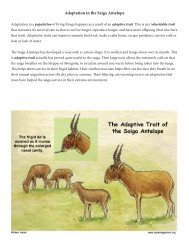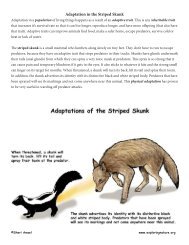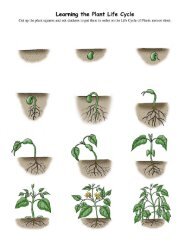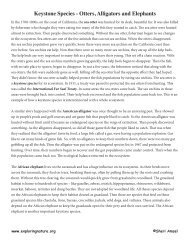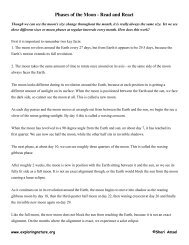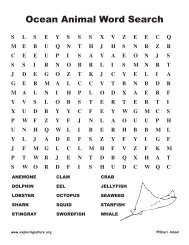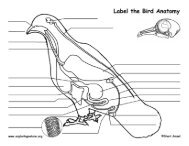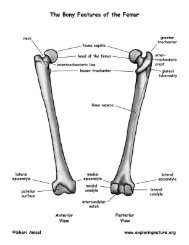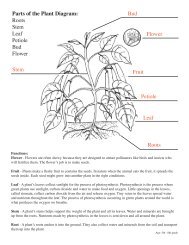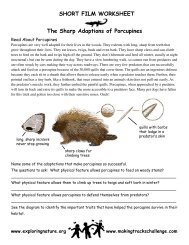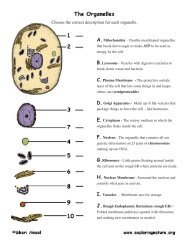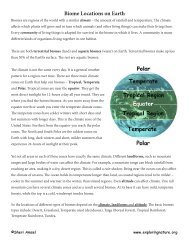What grows there?
What grows there?
What grows there?
- No tags were found...
Create successful ePaper yourself
Turn your PDF publications into a flip-book with our unique Google optimized e-Paper software.
At first, students will have several unidentified plants intheir plots, so it is helpful for students to become familiarwith various plant traits (see NSTA Connection). As studentstry to identify the plant in their plots, ask questionssuch as, “Is the plant stem smooth or hairy? Are the edgesof the leaves entire (smooth or toothed)? Are leaves opposite(across from each other on the stem) or alternate (offset)?Are the leaves simple (plain oval shaped), or compound (dothey have many leaflets)? Are leaves lance-shaped (widerat the base and coming to a point at the end), oval (widerin the middle), or narrow (long and thin).”As the study continues each week, the level of detail instudents’ observations will increase, as will their ability toidentify plants. For example, students will begin to notesimilarities and differences between the species of plantsin their plot and comment on leaf shapes and edges, flowershapes and colors, etc.Once the plants have flowered, provide students withpaper and extra time to sketch their plants. These canbe simple renditions. Have students focus on leaf patternson the stem (opposite or alternate), leaf shape (theleaves on the stem, not at the base of the plant, as theycan be quite different), flower location on the plant, andflower shape.Remind students to record the date each plant flowersand to note if they see insects pollinating their plants, andif so, what kind of insect. Every week or so, spot check tomake sure students are using their data sheets correctly.Making ConnectionsAfter a few weeks of observation, bring students togetherto discuss their experiences. Ask questions like, “Whichplant is the tallest?” and “Which plant flowered first?”“Which plant do you see the most of in your plot?”“Does it seem like your tallest plant has stopped growing?If so, what is it doing now?”Introduce the idea that plants compete with each otherfor sunlight and space and that the speed of plant growthis a factor in a plant’s survival in their habitat. Did thefaster-growing plants crowd out the smaller plants?Point out the comparison that, in the animal world,the strongest predator gets the most food, while in theFigure 2.Plant growth recording sheet.Plant height(each box is 3 cm)3 cm = 1.18 inchWhen plants flowerPlant names(or numbers) indifferent colorsWeek 1 Week 2 Week 3 Week 4 Week 5 Week 6Days and weeks of the growth study46 Science and Children
<strong>What</strong> Grows There?plant world the most efficient collector of sunlight makesthe most food. Animal scavengers often prosper becausethey take leftover food without expending the energy tohunt and kill prey. Compare this to plants that grow moreslowly, bloom later in the season, and take advantage of lateseason sunlight without competing with early fast growers.(This is an oversimplification, but it helps illustrate theconcept of a plant niche.) These conversations will helpraise students’ awareness of plants as they discover thatplants grow at different rates (speeds), grow to differentsizes, and flower at different times.Analyzing ResultsAt the end of observation period and after additionalfollow-up discussions, help students connect the pointson the data chart and discuss what the graph they havecreated reveals. Students should be able to tell1. How tall the plants grew compared to one another.2. How quickly the plants grew and flowered comparedto one another.3. If the plants continued to grow taller after they flowered.4. Which plants out-competed the others for sunlightand space over the duration of the study.Help students understand that this data is showing thatplants compete with each other for sunlight and spaceand that how fast plants grow is important to their survivalin their habitat. To guide the discussion, ask studentsto look at the plant heights at the beginning of thestudy. (Plants should be similar heights at first.) Then,have students note the plants that got taller faster. <strong>What</strong>happened to the growth of the other plants? (It was muchslower or stopped altogether.) If the research goes onlong enough, students will observe that the fast plantsstop growing at a certain height, flower, make seeds, anddie. Ask students if other plants then grew taller. (Studentsshould see secondary growth of late bloomers likegoldenrod and ragweed.)Students might also recognize water and pollinators asother important resources that affect plant growth. In addition,students may begin to realize how important plantsare in supplying food to the bottom of the food web. Tohelp make these connections more apparent, ask studentshow they think rain affected the study (rain enhances plantgrowth). Would the plants have grown the same way in adrought? In what other ways might plants be pollinatedbesides by insects? (wind).AssessmentsAfter these discussions, present students with the preassessmentquestions from the beginning of the studyand have them answer them again. Charting plantslends itself to numerous opportunities for students todemonstrate what they have learned. For example, studentscould:• Bring younger students to their plots and describetheir study.• Give a flora tour for other students and theirparents.• Create a plant mural, doing to-scale (accurate adultheights) drawings of local flora with plant facts tohang in the school hallway.• Publish their findings online.Sharing what they learned with other students and familymembers will help reinforce the knowledge studentsattained from the activity, give them a sense of pride inthis new knowledge, and foster a greater sense of their ownability to learn science. For students who do not spendmuch time outside, this activity will raise their comfortlevel with getting right out <strong>there</strong> in the grass and lookingat things. nSheri Amsel (sheri@exploringnature.org) is author/illustrator of more than 20 books for children on natureand the outdoors and the science coordinator for ExploringNature Educational Resource, an award-winningscience reference website.Internet ResourcesExploring Nature Educational Resourcewww.exploringnature.org/database/wildflower_index.phpMaking Tracks Wildflower Field Guidewww.makingtrackschallenge.com/tg/view_wildflowers.phpNSTA ConnectionDownload a blank plant growth chart and aplant traits worksheet at www.nsta.org/SC0909.Connecting to the StandardsThis article addresses the following National ScienceEducation Standards (NRC 1996):Content StandardsGrades 5–8Standard C: Life Science• Structure and function in living systems• Regulation and behavior• Populations and ecosystems• Diversity and adaptations of organismsNational Research Council (NRC). 1996. Nationalscience education standards. Washington, DC:National Academy Press.September 2009 47



